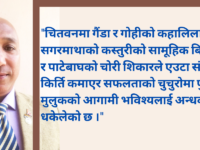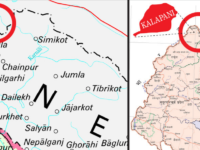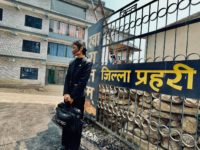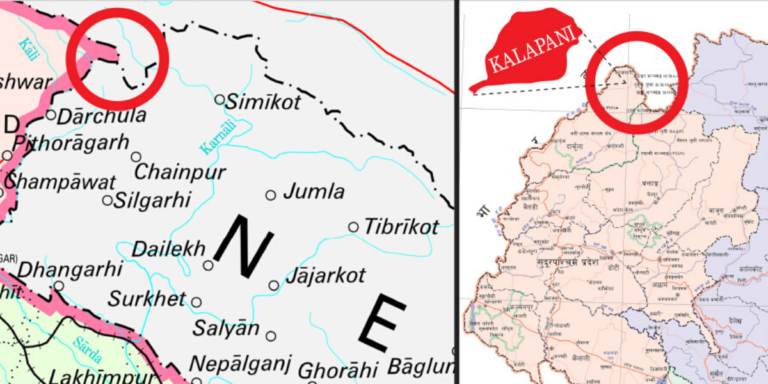By Om Tat Sat,
We must be grateful for India’s crucial role in helping and keeping Nepal a viable nation. Its nefarious activities always bring out the nationalism to ensure in igniting the unity of Nepalese. Nothing else comes even close to India’s big brother, goon like, manspreading policy in South Asia. Such an opportunity came recently when India’s Ministry of External Affairs released a map that showed part of Nepal falling in India, and Nepalese were reported to be barred from Nalapani and Lipulek. India’s MEA spokesperson has maintained that the map is accurate.
Why Nepalis are up in arms over India’s new political map #Kalapani pic.twitter.com/1K8CHfipIC
— Anup Kaphle (@AnupKaphle) November 12, 2019
Promptly, Nepalese were out on the street across the nation — burning the effigy of Indian PM Modi, displaying signs like “Back Off India,” shouting slogans and demanding rectification of the erroneous map that spelled naked aggression against Nepal. All the political parties were called to an emergency meeting to send a unified message to India.
Kalapani and Lipulekh is our land. It belongs to Nepal. #backoffindia pic.twitter.com/AzcoXyeYSk
— Santosh Chhetry (@chhetrySan) November 8, 2019
Indian encroachments of Nepalese border have made news time and again. Victimization of Indian aggression against Nepal comes in many varieties, but this time, something has hit the nerve that is unprecedented. It might be due to social media and the disappointment of Nepalese in the current government.
A solemn study of the issue brings out a fundamental picture. There is a problem regarding our border with both India and China. People are holding vigilance on the street on border encroachment news, while the political leaders are busy dismissing them as minor nuisance or trying to throw a veil of silence over people’s problems. Meanwhile many Nepalese farmers in border areas are left with no access to their land for which they carry Nepalese documents of ownership and proof of taxations. For the current land in news, there is a record of population survey and taxation going back to the 1950s from Nepal authority.
The primary reason these border disputes occur relate to the South Asian history. When these borders were marked during the Sugauli Treaty, Nepal government and Colonial British were the signatories. India was under the colonial rule then, thus played no part in it. According to the historical documents, correspondence and authority’s directives, Nepal sovereignty starts on the east of Kali river. The heart of the dispute arises from identification of Mahakali river. After the treaty, the Governor General instructed to the Commissioner of Kumau in 1817 that he should return the areas east of the Kali river to Nepal according to the Sugauli Treaty.
In the 1827 map drawn by British Surveyor of India, Mahakali river is clearly demarcated as the one starting from Limpiadhura. All the areas disputed by Indian aggressive policy fall east of that river, hence belong to Nepal. However, India played a trick by renaming the rivers. They named Kali river as Kutiyanti and named a small rivulet 30 km to the east as Kali. No open disputes started until 1962 when China and India went to war. After the war, it became beneficial for India to occupy the higher ground that fell in Nepalese territory so aggressively moved into Nepal’s Kalapani and Lipulek areas. Nepal merely lodged a protest. In the years since then Nepal’s diplomatic weakness has failed to make a stance and resolve the issue once and for all. Indian PM Modi made such a call during his first visit to Nepal in 2015. What’s keeping the Nepalese politicians from moving ahead?
Nepal has the option to involve the British with whom the treaty was signed and maps exist in US Congress and UK. Besides, there have been historical survey and population survey conducted by Nepal almost 60 years ago, and the surveyor who is now a well-known literary figure, is there to attest to the fact.
Border expert Buddinarayan Shrestha in his book Sima Sangram revealed that out of 1850 km border between India and Nepal, 660 km is disputed. Similarly, Nepal has 26 districts that share border with India and 23 of them have disputes in 71 places. The nature of disputes range from inundating Nepali land by the Indian border dams, roads and constructions, and making the old pillars disappear, then replace with smaller ones way inside Nepal, as well as Border Security Force personnel of India marching right into Nepal’s farms to destroy the crops and denying farmers any access. In Sarlahi district alone, 450 border pillars are reported to be missing, Changing course of rivers and the dam construction by India play big roles in pillars being swept away. India is reported to have captured 374 square kilometer of Nepal in Nalapani area alone, and total area of land usurped till now amounts to be equivalent to 15 Singapore, or 4 Israel.
Border encroachment of Nepal is not only India’s prerogative, it seems. China is also reported to have captured 36 hectares of land along the four districts in the north. Once China starts increasing the pace of development in Tibetan region, more land is expected to be encroached. Nepal government has taken the cowardice policy on border dispute to remain silent. Taking advantage of Nepal’s meekness, China and India agreed in 2015 to conduct trade through area that Nepal claims as its own, bypassing Nepal altogether in the negotiation.
There is only one reason for such aggression against Nepal. It is the political leadership that has failed to stand for border security, either by resolving it amicably, or by placing Nepal’s army in disputed area. Since the time of the monarchy, the problem has remained, and that is the unfortunate reality for Nepalese.
Despite all, the most disturbing aspect of the current incident is the government’s response. Police reacted with violence and arrested the agitating students who wanted to handover petition to the Indian embassy. Think about the message government has sent to the youth: “You have no right to protest against the encroachment of our border. Keep quiet or else.”
It is now up to the people to protect Nepalese borders. There are 60 Musahar families living at the border of Mahotari district, who have continuously fought against the Indian BSF force and their abuse to protect the border pillars. They live hand to mouth and even rely on India for their meager income. They should be given stipend and support for education and jobs, instead of discriminating against them in any way. The population living along the border had better be treated with respect and provide amenities for their staunch stance on behalf of their mother Nepal.
Will better judgment prevail?
he writer is a graduate of Arizona State University in Political Science. He is working as a social activist and motivational speaker for students across Nepal since 2007.
The views and opinions expressed in this article are those of the author and do not necesarily reflect the official policy or position of Nepalisite.






















